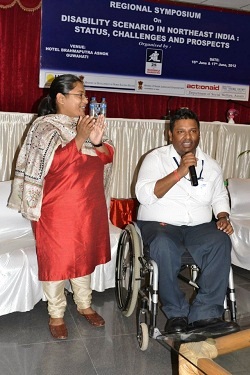Guwahati has grown into a city without really meaning to be a city. From a centre of pilgrimage to a boisterous city, from tin-roofed small houses to tall skyscrapers --- the city has grown seamlessly as the waters of the mighty Brahmaputra which flows by the side of the historic city. A recent survey (2006) by a popular Indian magazine - Outlook (Money) ranked Guwahati 16th among all the major and medium sized Indian cities.
But the individuals who lend a warmth and character to the city had never been celebrated. This is an attempt to honour Guwahatians who are either born in the city or have made the city their home and have been responsible for taking the name of the city to the world. The Thumb Print, a contemporary news magazine (www.thethumbprintmag.com) will honour the Giant Guwahatians from different walks of life who have left their imprint on the city.
Sriparna Baruah is deceptively mild-mannered and tentative. Camouflage for a formidable grit and determination. In 1999, Sriparna moved away from grooming management students at the Guwahati-based Assam Institute of Managment to an increasingly complex work of enhancing the entrepreneurial skills and creating job opportunities for the people of Northeast India – an activity that could not be easily digested or bought. At the management institute, her biggest challenge, then, was pretty basic yet indispensable – improving personal effectiveness of management students. But she preferred this job change at the newly established Indian Institute of Entreprenuership (IIE) at a lesser pay scale. It was her way of seceding from the market.
“My motivation to work was not money but the scope of work. I joined IIE as my scope of working in the entire Northeastern region would be much wider and meaningful,” she says in her characteristic soft voice. Initially with her academic background, she had first worked on a number of research projects. As a faculty member, she was involved with all the three major activities of the Institute – training, research and consultancy and is presently heading the Center for Industrial Extension at IIE. The excitement of working on research projects gradually diminished when she discovered that most research remained merely in the shelves of the sponsoring organizations with no concrete action. But this enthusiastic government official was enthused by the first cluster project taken up by IIE in 2005.
Surged by an urge to change lives of people around her, she found the concept very intriguing and volunteered to work on implementation of clusters. From the year 2006, she got involved in the implementation of clusters and shifted her focus from being an academician to field projects. She had travelled extensively throughout the Northeastern region to identify and implement projects. The first project was the Imphal Handloom cluster and from there went on to implement 16 such projects covering all the states of the region. This helped her understand the region better and also the type of intervention needed for making change. Her management background helped her to have a holistic perspective for development.
She was particularly interested in the rural enterprises which were mostly confined to the handloom and handicraft sector in region. And her love for art and crafts were sowed in her early years. While the nationalist movement was gathering momentum in India, a quiet revolution was happening elsewhere. As a little girl, Sriparna was enthused by stories of the freedom struggle told to her by her grandfather Dr Bhubaneshwar Barooah, noted physician and freedom fighter. Baruah always wanted to contribute her bit to the society and more importantly to stay in Assam and contribute to the development of her home state.
Her new job was fraught with challenges. Any development initiative through a government agency is looked at with suspicion “This has been my experience throughout the region. Skepticism is both at the field level and within the organization. Passion for work is often misconstrued as having a motive behind working hard,” she cringes. In the field, after the initial suspicion, intention is understood by the community at large, however at the organizational level there is a lot of resistance from co-workers. Then language is the biggest barrier. “Even though we keep saying that we have a large English speaking population, in reality, in semi-urban and rural areas, people can neither understand English nor Hindi,” she rues.
Art and craft is not something that is detached from life. She literally lives her work in her tastefully decorated living room. Tucked in a small hillock, almost hidden from the busy roads of Guwahati, her home is almost a repository of carefully collected artifacts. When she is not working, she tries to give quality time to her family and friends, reading and gardening is her passion. She also takes classes for MBA students. But her heart and soul lies with the entrepreneurs she has nurtured in the region. She defines an entrepreneur as a person who mobilises resources, innovates, undertakes risk and in the process he/she gains and the society also gains.
Her face lights up when she unwinds the story of NG Bimolata Devi, a talented member of the handloom project covering 5000 women weavers in East Imphal district. She decided to work in Manipur when there were no good stories from the state, only the difficult, ambiguous, unresolved ones. In fact, she is one of the few master weavers who could speak in Hindi and in the process became the anchor for Sriparna. Hailing from a small village called Achanbigu Mayai Leikai of Imphal East district, Bimolata was full of enthusiasm but was inhibited and shy. But she is a quick learner and immediately understood the benefits of working in a group and the need for addressing the macro issues facing the handloom industry. She had played a crucial role in setting up the yarn bank in Imphal which now assists more than 2500 weavers to reap the benefit of procuring yarn at a mill gate price. This has helped in reducing the cost of production considerably. Bimolata’s own collection is now marketed under the brand ‘Ningthebee’, which has become a fashion statement in Manipur.
Sriparna has cemented a close bond with Bimolata and many like her. Such bonding can lead to some strange moments. She smiles, “Bimolata calls me Madam but we are very close. When I was going through a bad phase because of office politics, she asked for my horoscope did a special puja which she has been doing only for her family members.”
Bimolata’s story is repeated across IIE’s clusters in other states in the region and that keeps Sriparna on her toes. From turning a BPL cluster in Pyranga village in Boko with no electricity and no commercial orientation has today become a hub of natural dyeing to the wood carpentry cluster of Baktwang village of Mizoram in which the artisans had no bank account four years back, is today not only financially sound but also has entrepreneurs making knocked down furniture and using social media like facebook to market their products. She is also enthusiastic about a strawberry project in Meghalaya has seen change in lives and income of the farmers.
They are the real India for her. Sriparna is a novel management guru who has an unusual network of friends at the grassroots --- farmers, weavers, craftsmen, storytellers and carpenters. She never wanted to be an entrepreneur herself but she feels she is enterprising in whatever she does. She works at an instinctual level and her life reveals her work.
This article was earlier published in The Assam Tribune.







































